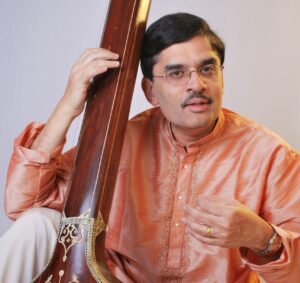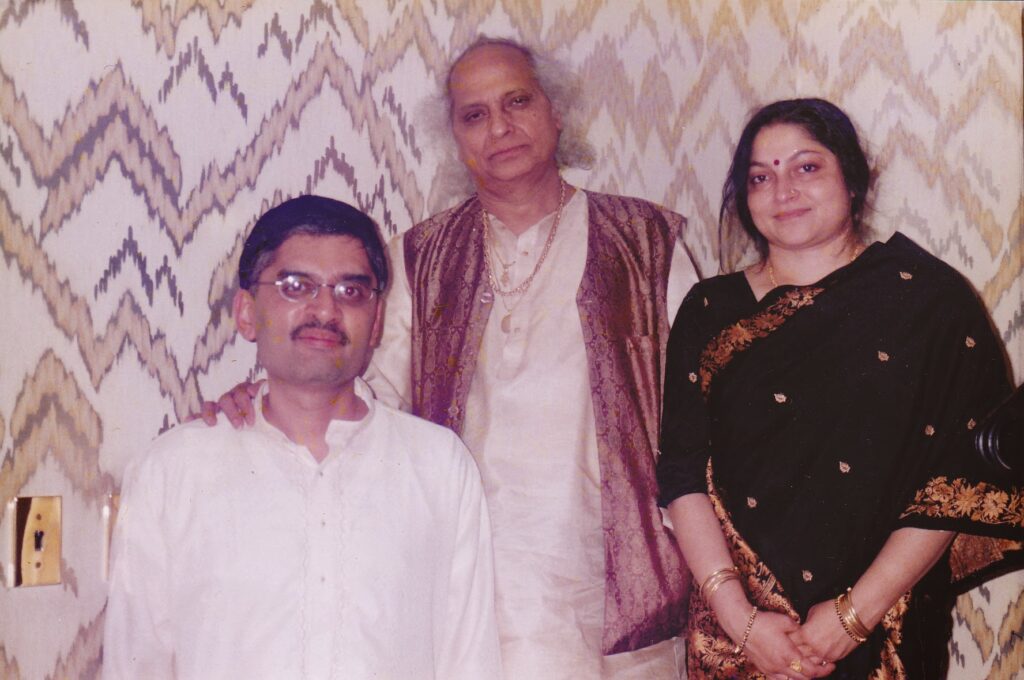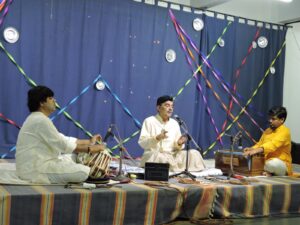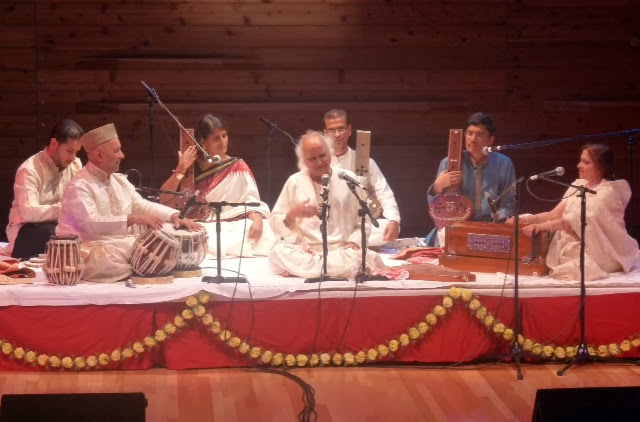Invited Article
Volume 14 Issues 1 January, 2024

Raag and Rhythm for Health
New Jersey, USA
It was November 2023. I was talking to my former classmate Sanjay in Pune who is now retired after a successful career. His main worry was that he could not fall asleep no matter how hard he tried. Getting a good 7-to-8-hour sleep was hard for him and he felt very tired all the time.
As a Hindustani Classical vocalist, I had learned from Guruji that listening to Raag Darbari can cause the listener to fall asleep. So, I recorded a short 20-minute Alap, followed by a short Bandish (composition) in Raag Darbari for Sanjay. Alap is just the unfolding of the musical notes (Swars) that form a Raag (or the melody). Sanjay listened to the recording regularly for about 2 weeks. He was seeing a definite improvement. After listening to the recording, he was able to fall asleep.
In April 2024, I was talking to a psychiatrist friend Dr. Shashi in New Jersey, USA. Dr. Shashi mentioned to me that she was suffering from sleeplessness. I just forwarded the same recording that I had made for Sanjay. A few days later, Dr. Shashi said that the Darbari Alap brought her close to sleep but when she heard the Bandish, her mind got activated. So, she skipped the Bandish, started the Alap again and that helped. The above two incidents about Raag Darbari as a remedy for sleeplessness were an eye opener for me!
Raag and Rhythm for Health Launch
It was a great coincidence that in May 2024, I met Dr. Asawari Thombre who is a well-known music therapist based in Pune. After talking to a few musician friends, we decided to start a monthly Podcast series under the name of “Raag and Rhythm for Health”.
We formed a team in which I would sing, Shailesh Chirputkar played harmonium, Gopal Kalluri and Rajeev Kumar played Tabla and Madhu Kshirsagar would play the flute. We took music therapy related inputs from Dr. Thombre and decided that “Raag and Rhythm for Health” will be a social service and free music podcasts will be delivered through WhatsApp.
On June 1, 2024, we shared the first Podcast about reducing inertia in the morning. I sang the Alap in Raag Bairagi Bhairav and a Bhajan to wake up Bhagwan Shri Krishna in the morning. A link to the Podcast audio file was sent through WhatsApp, to hundreds of listeners and the feedback we received was very positive. Many listeners said that the feeling of sluggishness in the morning was gone after listening to the Podcast. The audience seemed eager to receive more podcasts!
About the Author: Shri Suhas Joshi is a disciple of Padmashri Pandita Tripti Mukherjee and a grand disciple of Sangeet Martand Padma Vibhushan Pandit Jasraj ji. As a member of the Mewati Gharana, he has sung in many concerts in India, USA, Canada, Europe and the Bahamas. His CD “Mewati Offerings” was published a few years ago. He has sung on radio, the Internet, and TV in India and the USA. Suhas ji is a recipient of the “Mewati Adyashri” and “Mewati Pradeept” awards.

After a successful launch of the Podcast series in June, our team has released 6 more Podcasts in 2024, as remedies for Acidity (Raag Komal Rishabh Asawari), High Blood Pressure (Ragas Madhuvanti and Yaman), Asthma (Raag Miyaki Malhar), Diabetes (Raag Shree) and Insomnia (Raag Darbari).
Comments from “Raag and Rhythm for Health” Listeners
A few comments we received are worth sharing here.
“My mind became calm and more focused. Decision making capability improved.” – New Jersey, USA
“Helped my mind move away from joint pain due to Chikungunya. Felt a sense of positive energy” – Ratnagiri, India
“Definitely helped me calm down. At the end of the day, I sleep better.” – Atlanta, USA
“Felt like healing from deep sadness and the inner spirit experienced a very abstract (Nirakar) emotion.” – New Jersey, USA
“I saw much happiness, joy and hope in the music.” – Delaware, USA
“Gave me much needed relief and brought peace to my mind when I was recovering after a complex bone surgery.” – New Jersey, USA
Raag and Health Connection
You may be wondering about how listening to a Raag helps in maintaining and improving mental and physical health. An explanation using the Raag Samay Chakra (Time Cycle) and Ayurveda is as follows. Ayurveda recognizes three energy forces (Doshas) within the body called Kafa, Pitta and Vata. Kafa represents stability, Pitta represents intensity and Vata represents movement. When there is imbalance across these forces, it results in a mental or physical disorder. A 24-hour day is divided into 8 intervals (Prahar) of 3 hours each. Hindustani Classical Music theory recommends ragas for each Prahar. In the morning (4 to 10 AM), the body has a high degree of Kafa. Ragas such as Bhairav, its variations, Raag Todi and its variations are recommended for these periods. These Ragas emphasize 3 musical notes (Swars) Sa, Re and Ga. Listening to these Swars causes the body to reduce Kafa and increase Vata. Reduction in Kafa reduces inertia and increase in Vata increases agility.
Between the hours of 10 AM to 4 PM, Ragas that emphasize Swars Ma and Pa are recommended. Examples of such Ragas include Sarang, Multani and Bhimpalasi. These Ragas regulate Pitta and Vata, which helps in digestion of lunch and blood circulation. During the hours of 4 to 10 PM, especially around the time of sunset, anxiety increases. There is a need to relax after a day’s hard work. Ragas recommended for this time interval include Marwa, Puriya Dhanashri, Shree, Yaman, Kafi and Khamaj. These ragas regulate Pitta and Vata in the body thereby giving hope and providing relaxation.
In the night, i.e. from 10 PM to 4 AM, the mind needs to be calm, and the body needs to relax. Ragas such as Darbari, Bageshri and Malkauns increase Kafa which results in sound sleep. Pitta and Vata are regulated which results in better energy distribution within the body. It is a well-known fact that if a listener listens to a morning Raag like Ahir Bhairav during the night, the listener will not fall asleep because Ahir Bhairav gets the mind energized and excited, instead of making it calm.
Raag and Chakra Connection
Since ancient times, people have believed that there are 7 energy centers (Chakras) in the body. They regulate the physical, mental and spiritual activities in the body. It is believed that there are 7 Chakras just as there are 7 Swars. Each Swar stimulates a specific Chakra. For example, the base note “Sa” activates the Muladhar Chakra. Muladhar Chakra is said to control energy, stability, courage and physical desires.
Rhythm and Health Connection
Rhythm or tempo provides structure and flow to music. A faster tempo creates excitement. A slower tempo gives a calm feeling. A percussion instrument such as Tabla provides the rhythm. During the Alap there is no Tabla accompaniment, and the listener is immersed in the Raag Swars. Unlike a quick song that gets over in 3 to 5 minutes, a prolonged Alap will surround and engulf the listener with the Raag Swars. The composition presented after the Alap is set to a specific tempo. The composition helps the listener connect with the Raag.
Conclusion
It is scientifically proven that when people listen to their favorite music, it creates low frequency alfa waves in the brain, thereby reducing anxiety. Music also increases Dopamine and Serotonin levels which increase the feeling of well-being and elevate the mood. Music may increase the level of endorphins that reduce the pain. Finally, it is well-known that music decreases Cortisol in the blood which reduces stress.
In general, music is a source of relaxation, a way to escape boredom and to get energized. Like any other form of music, classical music can be a source of relaxation and energy. Additionally, it can be therapeutic.
A raag weaves a framework of Swars around the listener. Depending on the Raag, there is a positive impact on the mind and the body. As evidenced through the Raag and Rhythm for Health podcasts, listening to a Raag helps in managing a disorder and that leads to a faster recovery. A raag will increase peace of mind and positivity, which will increase the effectiveness of medication.

Welcoming New Listeners
Based on popular demand, we will continue to produce Raag and Rhythm for Health podcasts in 2025 and share them free of charge. People interested in receiving the Raag and Rhythm for Health Podcasts, should please send an email to RaagAndRhythmForHealth@gmail.com. In the message, please provide your name and the mobile number on which you would like to receive the free Podcasts through WhatsApp. The Podcasts are distributed through a WhatsApp distribution list, which ensures the privacy and security of each recipient.


